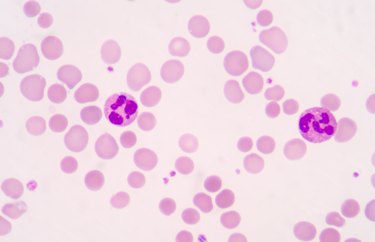
Your body contains thousands of genes, which code for thousands of different proteins. Each protein, which is made up of a sequence of amino acids, contributes to the structure or function of your cells by supporting your metabolism, promoting cellular communication, and supporting the shape and structure of your cells. Each of your proteins has a primary structure, which is important for how the protein functions.
Protein Structure
Video of the Day
Protein structure is classified on four levels: primary, secondary, tertiary and quarternary. The primary structure of proteins refers to the sequence of amino acids that make up a protein chain, or polypeptide. Each protein has a unique primary structure that differs in both the order of amino acids in the polypeptide and the total number of amino acids that make up the protein molecule. The secondary and tertiary structures refer to the way the polypeptide is twisted and bent into a three-dimensional shape to make a functional protein. Quaternary structure refers to the way two or more polypeptides interact to make up a functional protein. Every protein in your body has a primary, secondary and tertiary structure, but only some proteins have a quaternary structure.
Video of the Day
Hemoglobin
One example of a protein with a primary structure is hemoglobin. This protein, found on your red blood cells, helps provide the tissues throughout your body with a constant supply of oxygen. The primary structure of hemoglobin is important because a change in only one amino acid can disrupt hemoglobin's function. For example, a single amino acid change to hemoglobin's primary structure can cause sickle cell anemia, a blood condition characterized by dysfunctional, sickle-shaped red blood cells.
Hexosaminidase
Another protein with important primary structure is hexosaminidase, a protein that contributes to the function of cellular compartments called lysozymes. Maintaining lysozyme function is important to your health, since these compartments help your cells dispose of molecules that might otherwise harm the cell. A mutation in the primary structure of hexosaminidase can disrupt lysozyme function in the brain, leading to fatal Tay-Sachs disease. As a result, babies often undergo genetic testing for hexosaminidase mutations, to aid in early diagnosis of the disease.
Dystrophin
Dystrophin is another protein with a primary structure. The presence of dystrophin contributes to muscle functioning, and the protein helps maintain the structure of your muscle fibers. Genetic mutations that change the primary structure of dystrophin -- such as the substitution of one amino acid for another, or deletions of amino acids -- can harm your muscle fibers, leading to diseases such as Duchenne muscular dystrophy.